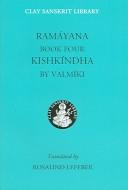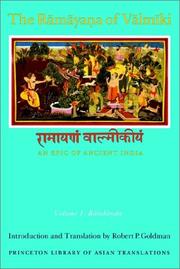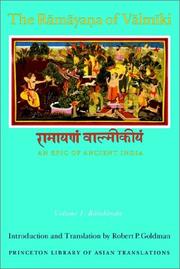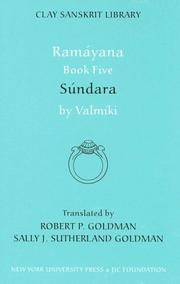| Listing 1 - 10 of 27 | << page >> |
Sort by
|

ISBN: 0814731635 9780814731635 Year: 2005 Publisher: New York: New York University press,
Abstract | Keywords | Export | Availability | Bookmark
 Loading...
Loading...Choose an application
- Reference Manager
- EndNote
- RefWorks (Direct export to RefWorks)
Rama, the crown prince of the city of Ayódhya, is a model son and warrior. He is sent by his father the king to rescue a sage from persecution by demons, but must first kill a fearsome ogress. That done, he drives out the demons, restores peace and attends a tournament in the neighboring city of Míthila; here he bends the bow that no other warrior can handle, winning the prize and the hand of Sita, the princess of Míthila. He and Sita and his brothers and their wives return in triumph to Ayódhya, and are fêted. The epic proper is prefaced by an elaborate account of the origins of the poem and of poetry itself and a description of its early mode of recitation. This preamble is of great importance to an understanding of traditional Indian thinking on the subject of emotion and literary process.
Book
ISBN: 0231039417 Year: 1977 Publisher: New York (N.Y.) : Columbia university press,
Abstract | Keywords | Export | Availability | Bookmark
 Loading...
Loading...Choose an application
- Reference Manager
- EndNote
- RefWorks (Direct export to RefWorks)

ISBN: 069101485X 9780691014852 0691065616 1400884551 Year: 1984 Publisher: Princeton University Press
Abstract | Keywords | Export | Availability | Bookmark
 Loading...
Loading...Choose an application
- Reference Manager
- EndNote
- RefWorks (Direct export to RefWorks)

ISBN: 9781400884551 9780691014852 069101485X Year: 1984 Publisher: Princeton: Princeton university press,
Abstract | Keywords | Export | Availability | Bookmark
 Loading...
Loading...Choose an application
- Reference Manager
- EndNote
- RefWorks (Direct export to RefWorks)
Book
ISBN: 9788173048654 8173048657 Year: 2010 Publisher: New Delhi: Manohar,
Abstract | Keywords | Export | Availability | Bookmark
 Loading...
Loading...Choose an application
- Reference Manager
- EndNote
- RefWorks (Direct export to RefWorks)
Robert P. Goldman, b. 1942, American Indologist; contibuted articles.

ISBN: 9780814731789 0814731783 Year: 2006 Publisher: New York: New York University press,
Abstract | Keywords | Export | Availability | Bookmark
 Loading...
Loading...Choose an application
- Reference Manager
- EndNote
- RefWorks (Direct export to RefWorks)
The fifth and most popular book of the Ramáyana of Valmíki, Súndara recounts the adventures of the monkey hero Hánuman leaping across the ocean to the island citadel of Lanka. Once there, he scours the city for the abducted Princess Sita. The poet vividly describes the opulence of the court of the demon king, Rávana, the beauty of his harem, and the hideous deformity of Sita's wardresses. After witnessing Sita’s stern rejection of Rávana's blandishments, Hánuman reveals himself to the princess, shows her Rama's signet ring as proof of identity, and offers to carry her back to Rama.
Book
Year: 1992 Publisher: New Delhi : Munshiram Manoharlal,
Abstract | Keywords | Export | Availability | Bookmark
 Loading...
Loading...Choose an application
- Reference Manager
- EndNote
- RefWorks (Direct export to RefWorks)
Book
ISBN: 9788120833753 8120833759 9788120832947 8120832949 Year: 2009 Publisher: Delhi : Motilal Banarsidass Publishers,
Abstract | Keywords | Export | Availability | Bookmark
 Loading...
Loading...Choose an application
- Reference Manager
- EndNote
- RefWorks (Direct export to RefWorks)
Book
ISBN: 9780691225029 Year: 2022 Publisher: Princeton, NJ
Abstract | Keywords | Export | Availability | Bookmark
 Loading...
Loading...Choose an application
- Reference Manager
- EndNote
- RefWorks (Direct export to RefWorks)
Book
ISBN: 9781400883103 Year: 2016 Publisher: Princeton, NJ
Abstract | Keywords | Export | Availability | Bookmark
 Loading...
Loading...Choose an application
- Reference Manager
- EndNote
- RefWorks (Direct export to RefWorks)
| Listing 1 - 10 of 27 | << page >> |
Sort by
|

 Search
Search Feedback
Feedback About UniCat
About UniCat  Help
Help News
News